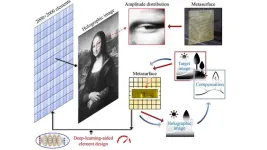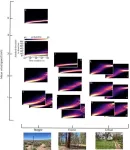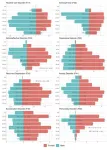(Press-News.org) Researchers at the Francis Crick Institute have identified three 4,000-year-old British cases of Yersinia pestis, the bacteria causing the plague – the oldest evidence of the plague in Britain to date, reported in a paper published today in Nature Communications.
Working with the University of Oxford, the Levens Local History Group and the Wells and Mendip Museum, the team identified two cases of Yersinia pestis in human remains found in a mass burial in Charterhouse Warren in Somerset and one in a ring cairn monument in Levens in Cumbria.
They took small skeletal samples from 34 individuals across the two sites, screening for the presence of Yersinia pestis in teeth. This technique is performed in a specialist clean room facility where they drill into the tooth and extract dental pulp, which can trap DNA remnants of infectious diseases.
They then analysed the DNA and identified three cases of Yersinia pestis in two children estimated to be aged between 10-12 years old when they died, and one woman aged between 35-45. Radiocarbon dating was used to show it’s likely the three people lived at roughly the same time.
The plague has previously been identified in several individuals from Eurasia between 5,000 and 2,500 years before present (BP), a period spanning the Late Neolithic and Bronze Age (termed LNBA), but hadn’t been seen before in Britain at this point in time. The wide geographic spread suggests that this strain of the plague may have been easily transmitted.
This strain of the plague – the LNBA lineage – was likely brought into Central and Western Europe around 4,800 BP by humans expanding into Eurasia, and now this research suggests that it extended to Britain.
Using genome sequencing, the researchers showed that this strain of the Yersinia pestis looks very similar to the strain identified in Eurasia at the same time.
The individuals identified all lacked the yapC and ymt genes, which are seen in later strains of plague, the latter of which is known to play an important role in plague transmission via fleas. This information has previously suggested that this strain of the plague was not transmitted via fleas, unlike later plague strains such as the one that caused the Black Death.
Because pathogenic DNA – DNA from bacteria, protozoa, or viruses which cause disease – degrades very quickly in samples which might be incomplete or eroded, it’s also possible that other individuals at these burial sites may have been infected with the same strain of plague.
The Charterhouse Warren site is rare as it doesn’t match other funeral sites from the time period – the individuals buried there appear to have died from trauma. The researchers speculate that the mass burial wasn’t due to an outbreak of plague but individuals may have been infected at the time they died.
Pooja Swali, first author and PhD student at the Crick, said, “The ability to detect ancient pathogens from degraded samples, from thousands of years ago, is incredible. These genomes can inform us of the spread and evolutionary changes of pathogens in the past, and hopefully help us understand which genes may be important in the spread of infectious diseases. We see that this Yersinia pestis lineage, including genomes from this study, loses genes over time, a pattern that has emerged with later epidemics caused by the same pathogen.”
Pontus Skoglund, group leader of the Ancient Genomics Laboratory at the Crick, said, “This research is a new piece of the puzzle in our understanding of the ancient genomic record of pathogens and humans, and how we co-evolved.
“We understand the huge impact of many historical plague outbreaks, such as the Black Death, on human societies and health, but ancient DNA can document infectious disease much further into the past. Future research will do more to understand how our genomes responded to such diseases in the past, and the evolutionary arms race with the pathogens themselves, which can help us to understand the impact of diseases in the present or in the future.”
-ENDS-
Peer reviewed
Observational study
People
For further information, contact: press@crick.ac.uk or +44 (0)20 3796 5252
Notes to Editors
Reference: Swali, P. et al. (2023). Yersinia pestis genomes reveal plague in Britain 4,000 years ago. Nature Communications. 10.1038/s41467-023-38393-w.
More information about the Bronze Age
The Bronze Age in Europe started in 3200 BC and lasted until 800 BC. It was the first time humans started to work with metal, characterised by the use of bronze artefacts and implements.
In Britain, the Bronze Age coincided with movement of people into Britain around 4,400 years ago. This group of people can be identified as they were buried with distinctive artefacts like Beaker pottery, which were bell-shaped.
The Francis Crick Institute is a biomedical discovery institute dedicated to understanding the fundamental biology underlying health and disease. Its work is helping to understand why disease develops and to translate discoveries into new ways to prevent, diagnose and treat illnesses such as cancer, heart disease, stroke, infections, and neurodegenerative diseases.
An independent organisation, its founding partners are the Medical Research Council (MRC), Cancer Research UK, Wellcome, UCL (University College London), Imperial College London and King’s College London.
The Crick was formed in 2015, and in 2016 it moved into a brand new state-of-the-art building in central London which brings together 1500 scientists and support staff working collaboratively across disciplines, making it the biggest biomedical research facility under a single roof in Europe.
http://crick.ac.uk/
END
WASHINGTON, May 30, 2023 – Holograms are often displayed in science fiction as colorful, life-sized projections. But what seems like the technology of the future is actually the technology of the present, and now it has been used to recreate the Mona Lisa.
In Applied Physics Reviews, by AIP Publishing, researchers from Tianjin University, the Beijing Institute of Technology, Rowan University, the University of Missouri, Qingdao University, Shijiazhuang Tiedao University, and Beijing Jiaotong University developed an acoustic metasurface-based holography technique that uses a deep learning algorithm to generate and iteratively ...
WASHINGTON, May 30, 2023 -- How do flying insects like important pollinators locate odor sources in the great outdoors, despite encountering highly variable wind conditions? They use odor plumes — which travel like smoke and form when the wind blows odor molecules from their source — to track down sources such as flowers or pheromones.
But wind tunnels are typically unable to replicate realistic outdoor wind conditions. In Physics of Fluids, by AIP Publishing, University of Nevada at Reno researchers decided to explore microscale wind conditions in various outdoor environments to better understand what flying insects might experience while tracking odor plumes.
Authors ...
About The Study: The findings of this study that included 1,979 women indicate that healthy sleep measured prior to SARS-CoV-2 infection, both before and during the COVID-19 pandemic, may be protective against post–COVID-19 condition (PCC), also known as long COVID. Future research should investigate whether interventions on sleep health may prevent PCC or improve PCC symptoms.
Authors: Siwen Wang, M.D., of the Harvard T. H. Chan School of Public Health in Boston, is the corresponding author.
To access the embargoed study: ...
About The Study: In this study of 30,465 adults without myocardial infarction (MI; heart attack), stroke, or dementia, overall, incident MI was not associated with an acute decrease in global cognition, memory, or executive function at the time of the event compared with no MI. The rate of decline in global cognition, memory, and executive function was significantly faster over the years for adults with an MI event compared with those without an MI. These findings suggest that prevention of MI ...
About The Study: Using survey data from across the United States, researchers found that volunteering was associated with higher odds of excellent or very good health and flourishing in children and adolescents, and with lower odds of anxiety in adolescents and behavioral problems in children and adolescents.
Authors: Kevin Lanza, Ph.D., of the Michael & Susan Dell Center for Healthy Living in Austin, Texas, is the corresponding author.
To access the embargoed study: Visit our For The Media website at this link https://media.jamanetwork.com/
(doi:10.1001/jamanetworkopen.2023.15980)
Editor’s ...
About The Study: Use of and access to metabolic and bariatric surgery (MBS) have increased among U.S. youth and among most racial and ethnic groups. Compared with 2015-2019, MBS use in youths increased significantly in 2020-2021 during the first 2 years of the COVID-19 pandemic. In contrast, MBS rates in adults decreased in 2020.
Authors: Sarah E. Messiah, Ph.D., of the University of Texas Health Science Center at Houston School of Public Health—Dallas Campus, is the corresponding author.
To access the embargoed study: Visit our For The Media website at this link https://media.jamanetwork.com/
(doi:10.1001/jamapediatrics.2023.0803)
Editor’s ...
About The Study: The results of this study of 8,269 pediatric patients show disparities in central line–associated bloodstream infection rates for Black patients and patients who speak a language other than English that persisted after adjusting for known risk factors, suggesting that systemic racism and bias may play a role in inequitable hospital care for hospital-acquired infections. Stratifying outcomes to assess for disparities prior to quality improvement efforts may inform targeted interventions to improve ...
A survey of philosophers finds they broadly agree with economists on the best way of valuing the environment of the future in policy decisions made now – although for different reasons.
In a new study published in Nature Climate Change, environmental economists including the University of Exeter’s Professor Ben Groom found consensus between the two academic disciplines over an aspect of climate policy known as the ‘social discount rate’, with philosophers offering support for a rate of 2% - a value predominantly backed by economists, and which is in line with UN climate ...
A spacecraft can estimate the attitude state by comparing external measurements from attitude sensors with reference information. CubeSats tend to use 4-quadrant analog solar sensors which have the advantages of extremely low power consumption, minimal volume, low complexity, low cost, and high reliability as attitude sensors, considering the limitation of satellite volume and payload. The performance of the sensor can be importantly improved by the calibration procedure and compensation model. However, the various error sources affecting the calibration of the 4-quadrant sun sensor lead to a complicated ...
Being obese significantly increases the chances of also developing mental disorders. This applies to all age groups, with women at higher risk than men for most diseases, as a recent study of the Complexity Science Hub and the Medical University of Vienna shows. The results were published in the specialist journal "Translational Psychiatry".
“We analyzed a population-wide national registry of inpatient hospitalizations in Austria from 1997 to 2014 in order to determine the ...






